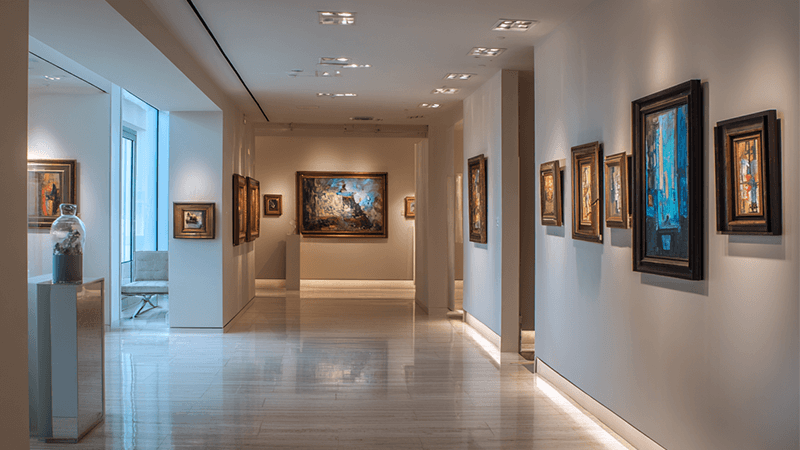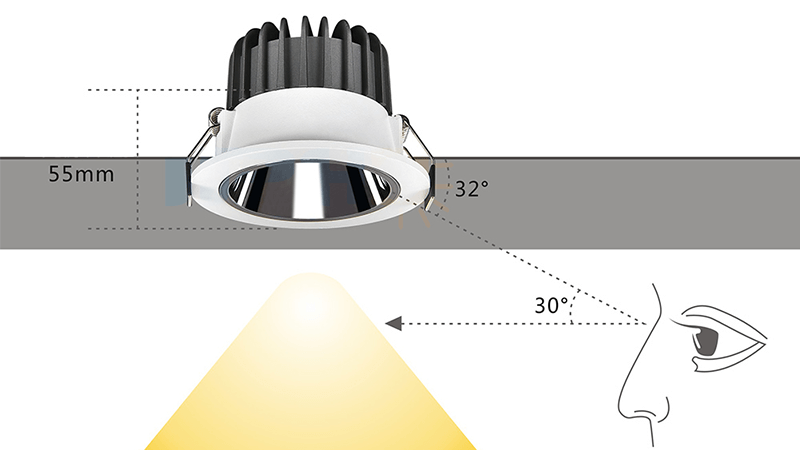Choosing the wrong light ruins priceless art. This damage is permanent and devalues the collection. Here's how to select lights that protect and enhance every piece perfectly.
To choose LED downlights for art galleries, you must prioritize lights with a high Color Rendering Index (CRI) of 95 or higher, zero UV/IR output, and excellent glare control (UGR<16). This ensures artwork is displayed accurately and preserved for the future without damage or distortion.

Selecting the right light for a museum is a serious responsibility. I've seen firsthand how the wrong choice can misrepresent an artist's work or even cause irreversible harm. It's not just about making a space bright; it's about revealing art in its truest form while protecting it for generations to come. The details matter more than you can imagine. Let’s break down what you truly need to look for.
What is the best lighting for art galleries?
Standard lighting can make colors look wrong. Worse, it can silently damage the very art you want to show. The right lighting brings art to life safely.
The best lighting is a high-quality, museum-grade LED1. It must have a CRI above 95, customizable beam angles, superior glare control, and produce no damaging UV or IR radiation. This combination protects the art and presents it accurately.

When I started in the lighting business, I thought "bright" was the most important thing. I quickly learned that for spaces like art galleries, that's not true at all. The most important thing is the quality of the light. Cheap LED lights can be silent destroyers of art. They might look fine, but they hide two major dangers.
The Invisible Dangers
First, there is ultraviolet (UV) and infrared (IR) radiation. Even tiny amounts of UV light can cause colors in paintings and fabrics to fade. It makes old paper brittle. IR radiation is essentially heat. It can change the temperature and humidity right around an object, causing stress and damage over time. A professional museum light is specifically engineered to filter out virtually 100% of this harmful radiation.
The Problem with the Spectrum
Second, there is the light spectrum2 itself. Most standard LEDs create white light using a blue chip coated in yellow phosphor. This creates a spectrum with a big spike in the blue range and gaps in other colors. This "spiky" light doesn't render colors accurately. Some sensitive pigments in older artworks can even be damaged by this intense blue light over the long term. High-quality museum lighting uses a much more advanced technology to create a full, continuous spectrum, almost like natural sunlight. This means the colors you see are exactly what the artist intended.
| Feature | Standard LED Downlight | Museum-Grade LED Downlight |
|---|---|---|
| UV/IR Radiation | May leak small, but harmful, amounts | Zero UV/IR output |
| Light Spectrum | Non-continuous, with a blue spike | Full, continuous spectrum |
| Color Rendering (CRI) | Often around 80 | 95 or higher (R9 > 90) |
| Preservation | Can cause fading and heat damage | Excellent for long-term preservation |
Should I use 2700K or 3000K for art?
Picking the wrong color temperature can ruin the mood. It can make a modern gallery feel old or a classic exhibit look sterile. Understanding the difference is key to success.
Use 3000K for a clean, neutral white light that suits most contemporary art galleries. Choose 2700K for a warmer, more intimate atmosphere, which works well for classical paintings and historical artifacts, creating a cozier, more traditional feel.

The choice between 2700K3 and 3000K4 is about creating an atmosphere. Think of it as setting the emotional tone for the entire gallery. There is no single "right" answer; it depends entirely on the art and the story you want to tell. A 3000K light feels crisp and modern. It makes whites look truly white and colors appear sharp and clear. This is often the preferred choice for galleries showing abstract, minimalist, or contemporary art.
On the other hand, 2700K mimics the warm glow of old incandescent bulbs. It creates a softer, more inviting, and historical feeling. This warmth can bring out the rich tones in oil paintings or the texture of aged wooden sculptures. I often recommend it for exhibits of classical masters or historical artifacts. But there's a major problem you must consider: dimming. Many projects require dimming5 to adjust light levels for different exhibitions or times of day. With cheap LEDs, when you dim the light, the color temperature can change. This is called "color shift6." A 3000K light might shift to a cold, unappealing 3500K at low brightness. Imagine a masterpiece looking perfect at 100% light, but then appearing blue or green when dimmed to 30%. This is unacceptable in a professional setting. High-quality fixtures maintain a stable color temperature across the entire dimming range, ensuring the art looks consistent no matter the brightness.
What is the difference between beam angle and lumens?
Focusing on lumens alone is a mistake. You could have very bright lights that just create glare and wash out the art. Getting the focus right is more important than pure power.
Lumens measure the total amount of light a bulb produces (brightness). Beam angle measures how focused that light is. A narrow beam angle concentrates the same lumens into a small, intense spot, while a wide angle spreads them over a large area.

Understanding the relationship between lumens7 and beam angle8 is fundamental to effective gallery lighting. It's the difference between simply flooding a room with light and carefully sculpting the environment to highlight each piece of art.
Lumens: The Raw Power
Lumens (lm) are a measure of total light output. A higher lumen count means a brighter light source. However, in an art gallery9, more lumens is not always better. Too much light can wash out the subtle details of an artwork and create uncomfortable glare for viewers. It's the starting point, but it doesn't tell you where that light is going.
Beam Angle: The Control
Beam angle is where the magic happens. It tells you how the light is distributed. A narrow beam angle, like 15 or 24 degrees, acts like a spotlight. It concentrates the light, creating high contrast and drawing the viewer's eye to a specific sculpture or a single painting. This is perfect for creating drama and focus. A wider beam angle, like 36 or 60 degrees, is a floodlight. It spreads the light out to wash a large wall evenly or provide general ambient lighting for a room.
Here's how they work together:
| Scenario | Desired Effect | Lumens | Recommended Beam Angle |
|---|---|---|---|
| Accent a Sculpture | High drama, strong highlight | Moderate | Narrow (15°-24°) |
| Light a Single Painting | Focused light, minimal spill | Moderate | Narrow (24°) |
| Wash a Large Wall | Even, uniform illumination | High | Wide (36°-60°) |
| General Room Lighting | Soft, ambient light | Moderate to High | Wide (60° or more) |
A skilled lighting designer10 uses a combination of different beam angles and lumen outputs to create layers of light. This gives the space depth, guides the visitor's journey, and ensures each artwork is presented in the best possible way.
What needs to be considered when specifying lighting for an art gallery?
It's easy to just pick a light. But not considering glare, adjustability11, and long-term quality will lead to a poor visitor experience12. You have to think beyond the basic specs.
Key considerations are: superior glare control (UGR<16)13, high CRI (>95), zero UV/IR, stable color during dimming, and the physical adjustability of the fixture. These factors combine to protect art and create an immersive, comfortable viewing experience.

When a client like Shaz comes to me for a gallery project, we move past the basic questions and dive into the critical details that define a world-class installation. It’s what separates a beautifully lit space from one that is merely bright. The goal is what I call "seeing the light, not the lamp." Visitors should be captivated by the art, not distracted by a bright glare from the ceiling.
Glare Control is Not Negotiable
The single most important factor for visitor comfort is glare control. Standard downlights often have the light source visible, which creates a bright, irritating spot in your peripheral vision. This causes eye strain and breaks the immersive experience. We look for fixtures with a deep-set light source and a well-designed anti-glare reflector. The metric for this is the Unified Glare Rating (UGR), and for museums, you should always aim for a UGR of less than 16.
Flexibility and Adjustability
Art exhibitions change. A lighting system must be flexible enough to adapt. This means specifying fixtures that can be easily adjusted. We need downlights that can be tilted (often up to 30 degrees) and rotated (a full 360 degrees). This allows the curator to precisely aim the light exactly where it's needed for a new exhibition without having to reinstall the lighting. Some advanced systems even offer interchangeable lenses, allowing you to change the beam angle on-site, providing the ultimate flexibility. A fixed, non-adjustable downlight is a poor long-term investment for a dynamic space like a gallery. These are practical details that make all the difference in the real world.
Conclusion
Choosing the right LED downlight protects priceless art, ensures true color representation, and creates a comfortable, immersive experience for every visitor in the gallery.
Museum-grade LEDs are essential for preserving art while providing accurate color representation. ↩
A full, continuous spectrum ensures accurate color rendering, preserving the artist's intent. ↩
2700K creates a warm, inviting atmosphere, ideal for classical and historical artworks. ↩
3000K provides a clean, neutral light that enhances modern artworks effectively. ↩
Understanding dimming helps maintain consistent lighting quality across different brightness levels. ↩
Color shift can distort the appearance of art, making consistent lighting crucial. ↩
Lumens measure brightness, but understanding their application is key to effective lighting. ↩
Beam angle determines how light is focused, crucial for highlighting specific artworks. ↩
Best practices ensure artworks are displayed beautifully and preserved for future generations. ↩
A skilled lighting designer creates immersive experiences that highlight artworks effectively. ↩
Adjustable fixtures allow for flexibility in lighting design, accommodating changing exhibitions. ↩
Effective lighting enhances engagement and appreciation of the art on display. ↩
Effective glare control improves visitor comfort and enhances the viewing experience. ↩

